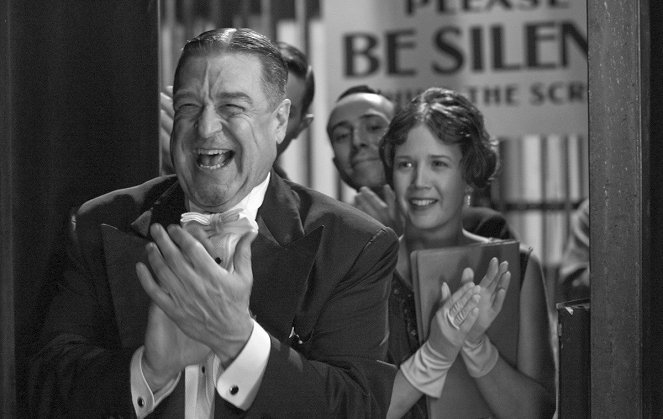Directed by:
Michel HazanaviciusScreenplay:
Michel HazanaviciusCinematography:
Guillaume SchiffmanComposer:
Ludovic BourceCast:
Jean Dujardin, Bérénice Bejo, John Goodman, James Cromwell, Penelope Ann Miller, Missi Pyle, Beth Grant, Ed Lauter, Elizabeth Tulloch, Ken Davitian (more)VOD (2)
Plots(1)
Hollywood 1927. George Valentin (Jean Dujardin) is a silent movie superstar. The advent of the talkies will sound the death knell for his career and see him fall into oblivion. For young extra Peppy Miller (Berenice Bejo), it seems the sky’s the limit major movie stardom awaits. The Artist tells the story of their interlinked destinies. (Entertainment in Video)
(more)Videos (37)
Reviews (12)
The pure charm of film escapism. A film about a time when celluloid burned, which burns itself and yet miraculously does not burn itself with too much reverence and foresight into the past. The work with a soundtrack and a silent film is a famous directorial move, not only because it cleverly brings to the fore what would never have stood out in a spoken film, but also because it is almost ingenious in its simplicity. A silent film that did not elevate its silence to a dubious fetish (let's love how beautiful it was, we will not see that anymore today), but the most significant narrative component (the film is magical in itself, not because it reminds us of something). Hazanavicius did work that I applaud. If any critics wrote of The Descendants as a worked gem, they mistook the film. This is a feel good gem from which my jaw dropped.
()
I wasn’t particularly enthused about this. I suspected that the film would not be quite right and that's why I postponed watching it. Then, just to be sure, I watched it again. It's not an entirely bad film, and if it inspires even a fraction of viewers to discover real silent films, then it has served its purpose. On the other hand, the story is just a continuation of the bad aspects of Singin' in the Rain, and I have a huge problem with that. The heroes of yesteryear can be none other than the combination of Rudolph Valentine, Douglas Fairbanks, and John Gilbert. Fortunately, there's also the cheerful studio owner and anyone from those legendary head honchos to William Randolph Hearst (played by the excellent John Goodman). The film also features a cleverly trained dog, believable sets, gorgeous costumes, a near-perfect final dance number, and some hope for a better tomorrow. What is somewhat deceptive is the sound nightmare and especially the 1936 song used as background for 1931. Equally problematic and redundant is the conveyance of actual footage from The Mark of Zorro (1920). The question thus remains whether the story of silent film is really interesting just because that era is long gone.
()
Incredibly sweet, playful, a delight for the eye, the ear and the spirit of all old people, among whom I also count myself. The dance number at the end was so terribly cute that I was grinning from ear to ear. And if I were a woman, I'd kill for Jean Dujardin's irresistible smile. Since I'm a man, at least my platonic love for Berenice Bejo will have to suffice :o)
()
Who would have thought that a silent film can astonish me even at a time when talkies are the norm and we’re seeing the rise of 3D movies? In fact, it is an absolutely beautiful throwback and homage to the film of the past. And this is what the very imaginative story of this movie is based on. Well, I have to admit that although Jean Dujardin seemed a bit crazy to me in his earlier films, here he showed that he’s a master of his craft even without sound. Perhaps I will never forget the scene where he appears at the ball, frowns and looks for something. There are so many emotions in that face that it can’t even be described. At that moment you’ll just fully understand what that means. And you’ll find out you can do without any lines or sound without a problem. The same goes for the final scene. I couldn’t imagine a more beautiful dance number. And shot in one go? Oh my God, is someone still filming such scenes these days? Hats off, for such a film experience does not occur every day. And that’s probably a good thing; thanks to this, this film gains a lot of uniqueness, which it will never lose.
()
The transition from the silent to the sound era was a major turning point in the world of cinema, and for many actors and directors who didn't want to adapt (or couldn't), it meant the end of a stellar career. This film nicely shows the tense situation of the late 1930s and very credibly and elegantly portrays the atmosphere and conditions in the film world at the time. As for the actors, I was satisfied, even if there's not much to say, it's all accompanied by apt and funny gestures. And the little dog was really cute. The music was a great second to the picture, as was the very sparse (but purposeful) use of sound. In short, a film that is a quality piece on all its levels, which is interesting mainly for its conception and technical execution.
()



Ads